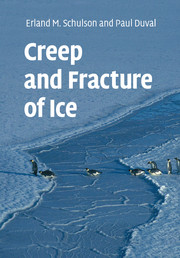Book contents
- Frontmatter
- Contents
- Preface
- Acknowledgements
- 1 Introduction
- 2 Structure of ice
- 3 Microstructure of natural ice features
- 4 Physical properties: elasticity, friction and diffusivity
- 5 Plastic deformation of the ice single crystal
- 6 Ductile behavior of polycrystalline ice: experimental data and physical processes
- 7 Modeling the ductile behavior of isotropic and anisotropic polycrystalline ice
- 8 Rheology of high-pressure and planetary ices
- 9 Fracture toughness of ice
- 10 Brittle failure of ice under tension
- 11 Brittle compressive failure of unconfined ice
- 12 Brittle compressive failure of confined ice
- 13 Ductile-to-brittle transition under compression
- 14 Indentation fracture and ice forces on structures
- 15 Fracture of the ice cover on the Arctic Ocean
- Index
- References
5 - Plastic deformation of the ice single crystal
Published online by Cambridge University Press: 01 February 2010
- Frontmatter
- Contents
- Preface
- Acknowledgements
- 1 Introduction
- 2 Structure of ice
- 3 Microstructure of natural ice features
- 4 Physical properties: elasticity, friction and diffusivity
- 5 Plastic deformation of the ice single crystal
- 6 Ductile behavior of polycrystalline ice: experimental data and physical processes
- 7 Modeling the ductile behavior of isotropic and anisotropic polycrystalline ice
- 8 Rheology of high-pressure and planetary ices
- 9 Fracture toughness of ice
- 10 Brittle failure of ice under tension
- 11 Brittle compressive failure of unconfined ice
- 12 Brittle compressive failure of confined ice
- 13 Ductile-to-brittle transition under compression
- 14 Indentation fracture and ice forces on structures
- 15 Fracture of the ice cover on the Arctic Ocean
- Index
- References
Summary
Introduction
Single crystals undergo plastic deformation as soon as there is a component of shear stress on the basal plane. Basal slip is observed for shear stresses in the basal plane lower than 0.02 MPa (Chevy,2005). Evidence of easy basal slip was first shown by McConnel (1891) and confirmed by many authors (Glen and Perutz, 1954; Griggs and Coles, 1954; Steinemann, 1954; Readey and Kingery, 1964; Higashi, 1967; Montagnat and Duval, 2004; see Weertman, 1973, for a review). A clear illustration of basal slip was obtained by Nakaya (1958) by performing bending experiments. Traces of the basal slip lines were made clearly visible by shadow photography (Fig. 5.1). Though some prismatic glide is observed for orientations close to those that inhibit basal slip, no clear observation of any deformation is reported in crystals loaded along the [0001] direction, which inhibits both basal and prismatic slip.
Basal slip takes place from the motion of basal dislocations with the Burgers' vector (Hobbs, 1974). The macroscopic slip direction corresponds to the maximum shear direction in the basal plane (Glen and Perutz, 1954). The slip direction is therefore always close to the direction of the maximum shear stress. From Kamb (1961), the failure to detect a slip direction in ice is explained by the fact that slip can occur in the three possible glide directions on the basal plane with a value of the stress exponent, which relates strain rate to stress, between 1 and 3.
- Type
- Chapter
- Information
- Creep and Fracture of Ice , pp. 77 - 100Publisher: Cambridge University PressPrint publication year: 2009
References
- 1
- Cited by



